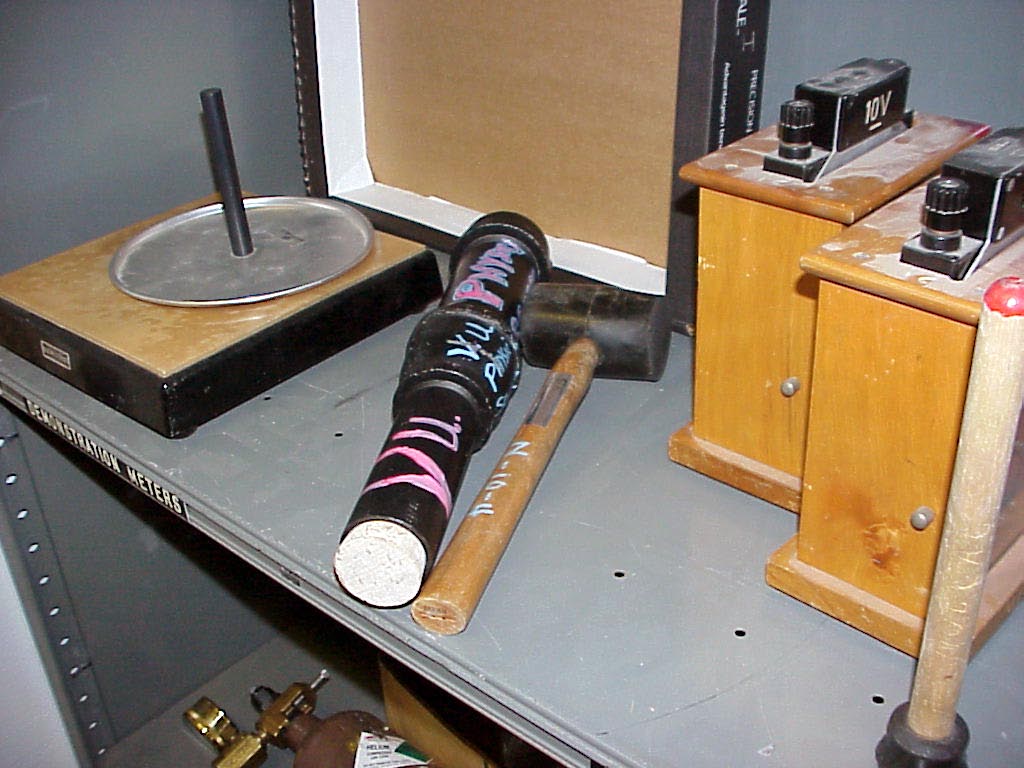Physics Demo Number: 100
Approximate Run Time: 5 min
Liquid Nitrogen Powered Pipe Bomb
Demo Description
A specially-constructed pipe 'bomb' is used to show the potential explosive power of liquid fuel changing to gas.
The bomb is "safe " in the sense that the only shrapnel that can , and indeed does, fly off is a light piece of cork.
The safeness of the bomb absolutely bars any tweaking with the apparatus or protocol of usage.
Such tweaking IS STRONGLY NOT RECOMMENDED UNDER ANY CIRCUMSTANCES, PERIOD.
Scientific Principles
-
Boiling
-
Boyles Law
-
Basis of Practical Rocket Propulsion
Equipment
-
Pipe Bomb
-
Cork
-
Rubber Hammer
-
Liquid Nitrogen
-
Stainless Thermos for Liquid Nitrogen ( fill this from big dewar and then pour from this into pipe bomb.)
Equipment Location
-
All Components (except for the liquid nitrogen itself) are in Kit (100) on [D-4-3].
-
The Dewar for Liquid Nitrogen is on [D-4-1].
Instructions

A view of the pipe bomb ( which is in reality a pipe used to shoot a cork projectile ) with cork end cap loosely inserted , is afforded by the first photo.

The
second photo shows a view of the pipe bomb with end cap cork
removed and looking straight into the muzzle of the pipe.
This end on view shows the shiny stainless steel insert in the bottom half of the pipe.
Since the pipe has a reducing coupler forming the mid-section, the stainless insert cannot come flying out as shrapnel under any circumstances of designed usage.
The crucial aspect of construction is that the insert has been placed in thermal insulating foam gel which hardened in place between the walls of the iron pipe and the outside of the insert minutes after construction.
Hence if the pipe is stood up on its securely threaded metal end cap and filled with liquid nitrogen up towards the top of the stainless insert, the nitrogen will boil for a little while and then settle into a quiescent state of thermal equilibrium.
USE ONLY THE STAINLESS STEEL THERMOS IN THE KIT TO FILL THE BOMB, regular thermos bottles can crack and implode if liquid nitrogen is placed in them.
At this point the cork cap can be pounded into place and be expected to remain for at least several minutes.
One now quickly tilts the pipe to a horizontal position and quickly back to vertical.
This action lets the liquid nitrogen inside the insulated insert splash onto the “hot” inner walls of the uninsulated upper half of the pipe resulting in new boiling , but this time inside a closed system.
DO NOT LEAVE PIPE POINTED AT STUDENTS OR LOOK AT THE CORK END ON. POINT IT AT CEILING towards the back of room and wait patiently.
The pressure builds rapidly enough to forcibly eject the cork with enough speed to carry it well towards the back of the room and emit a sound like a loud gun discharging.
Note that depending on the exact details of how much liquid nitrogen was placed in the insert and how much binding force is generated between the cork and throat of the pipe and the length of time in tilted position, there could be a hang-fire time delay of multiple seconds before detonation.
So, as with any potentially dangerous explosive device, one should keep the business end pointed in a safe direction at all times and be patient.
Writeup created by David A. Burba
Copyright © 2013, Vanderbilt University. All Rights Reserved.